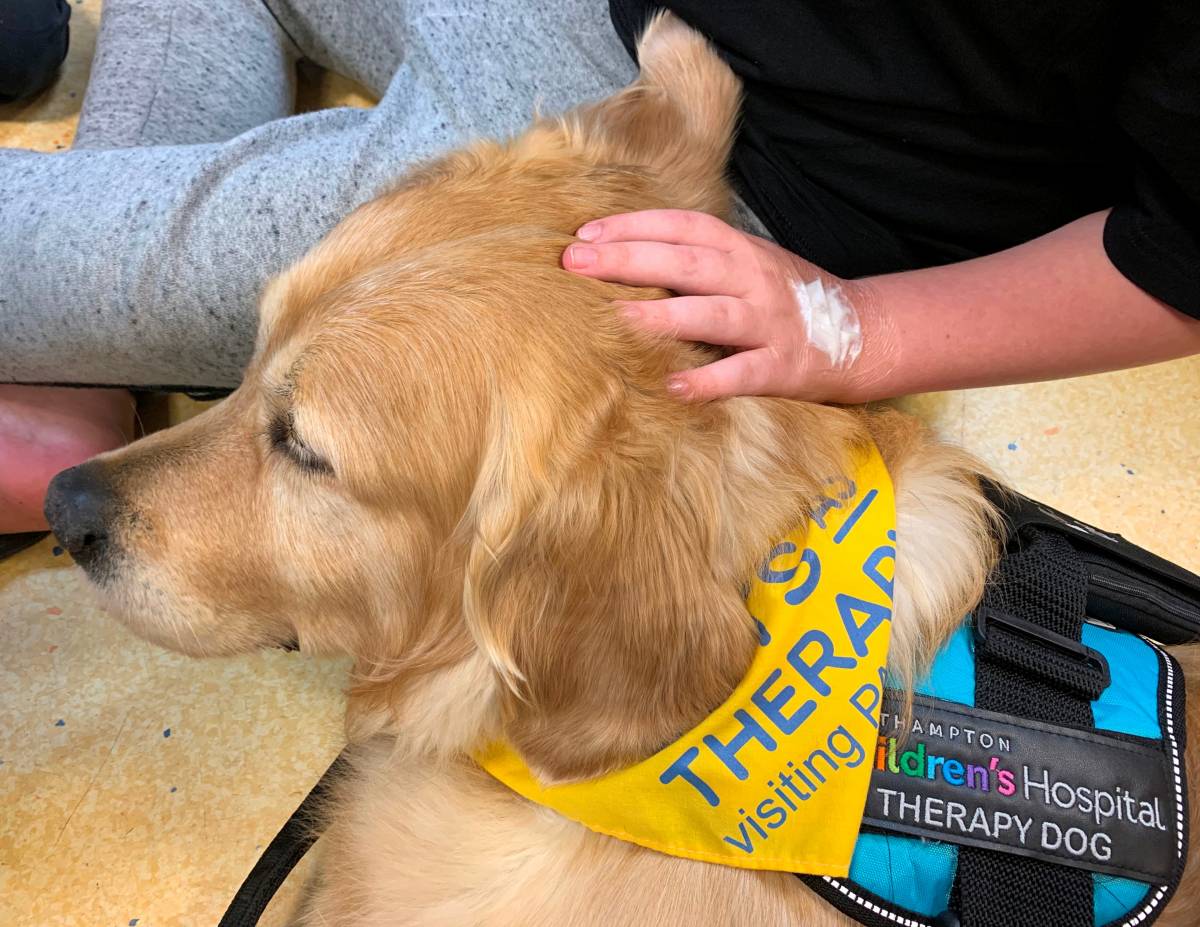Dog's visits to an intensive care unit motivated patients and staff, claims physiotherapist
Allowing a trained dog with a volunteer handler to visit an NHS intensive care unit (ICU) in Leicester proved to be a big hit among patents, staff and visitors alike, according to an article published in a specialist physiotherapy journal.
The article, which appears in the current issue of the Journal of the Association of Chartered Physiotherapists in Respiratory Care, was written by Ruth Johnson, an ICU physiotherapist at Leicester Royal Infirmary.

Ms Johnson’s article helps to plug something of a gap in the field, because the benefits of animal assisted interventions (AAIs) – defined as interventions between an animal and a patient during a medical, nursing or therapeutic procedure – have rarely been researched in critical care settings.
The dog, which a recent Twitter post from Ms Johnson suggests is called Cilla, was accompanied by a handler from a charity called Pets as Therapy.
No hygiene concerns
After the visits, most of which lasted fewer than 20 minutes with individual patients and were conducted on a weekly or fortnightly basis, questionnaires (which included a 10-point rating scale and invited written comments) were circulated to two groups: patients and visitors, and members of staff.
Summarising the responses received from 47 individuals, Ms Johnson writes: ‘There were no concerns in relation to the dog’s presentation, welfare, cleanliness or handling highlighted by responders.’
An overwhelming majority of patients and visitors said they had enjoyed the experience, with 83 per cent of them giving it the highest possible rating. A slightly lower percentage of staff (70 per cent) gave the same maximum score when asked to rate patients’ enjoyment levels, but three quarters of respondents (75 per cent) from both groups said they had found the experience to be ‘highly beneficial’.
Almost all (95 per cent) of respondents said they recommended that the AAI service should be introduced in other wards and hospitals.
The paper continues: 'The volunteer determined the length of the interaction dependent on the behaviour of the dog, person(s) involved and perceived benefit for all.
'Most interactions were less than 20 minutes long. The interaction involved verbal communication and touching the dog during periods of rest, delivery of care or treatment. The maximum total length of time the dog visited was 120 minutes on any one day, with regular welfare breaks for the dog.'
'Amazing interaction' noted by physio
EVERYWHERE should have this input. Nothing but positive experience and outcomes for all involved – patients, visitors and staff [nurse respondent]
One man said the dog’s presence had led to his partner walking ‘for the first time in days’. And a physiotherapist reported: ‘The therapy dog visited ITU today, the patient walked to (the dog) as her goal and this was amazing. The interaction between the patient and (the dog) was very emotional. This was an amazing way of encouraging mobility,’ the physiotherapist added.
A staff nurse’s comments showed that it was not just the patients who received some welcome stimulation from the dog’s visits. ‘EVERYWHERE should have this input. Nothing but positive experience and outcomes for all involved – patients, visitors and staff.'
The nurse added: ‘Staff actively look forward to the visit. And is often used as motivation and something to look forward to for patients.’
A doctor felt more compassionate
This perceived boost to the staff’s feelings of wellbeing was reinforced by the enthusiastic comments from a doctor on the unit, who said: ‘I really hope (the dog) will visit regularly during the winter pressures as I think staff will benefit so much, helping us all stay well for our patients.’
On a personal level, the doctor added that ‘the dog helped me to de-stress and helped me to deliver better, more compassionate care for our patient’.
Overcoming 'dehumanisation' effects
Ms Johnson’s article points out that significant numbers of patients who survive a critical illness go on to develop a condition known as post-intensive care syndrome.
Citing previous findings and National Institute for Health and Care Excellence guideline recommendations on critical care practice, she notes: ‘In modern critical care medicine, the promotion of recovery, over mere survival, for both physical and non-physical domains, is the main rehabilitation objective.’
Researchers have suggested that critical care patients require personalised rehabilitation prescriptions to meet their individual physical and non-physical needs, the article stresses.
Patients are at risk of ‘dehumanisation’, which can ‘negatively impact on patient engagement and interest in their own well-being during the rehabilitative phase’, Ms Johnson adds.
This evaluation identifies that a service providing AAIs to adult patients in ICU is safe and feasible ... it highlights additional perceived benefits for visitors, staff and patients [Ruth Johnson]
Ms Johnson suggests that the study could provide a basis for further research on AAI initiatives. She admits that a study of this nature cannot rule out bias, particularly as, in this case, the dog handler was also the researcher.
Allergy taken into account
Apparently, no one raised objections in advance regarding the dog’s visits – most of which took place during afternoon visiting hours. ‘Potential risks were identified during a pre-visit telephone call on the day of the visit. One staff member highlighted a mild dog allergy and the handler ensured that there was no contact between the dog and this staff member.’
In her conclusion, Ms Johnson writes: 'This evaluation identifies that a service providing AAIs to adult patients in ICU is safe and feasible. It highlights additional perceived benefits for visitors, staff and patients. In addition, a number of recommendations for service development and future research have been highlighted.’
To read the full version of Ms Johnson’s article, visit: https://www.acprc.org.uk/data/Journal_Downloads/JournalVol53Issue22021.pdf
To find out more about the Association of Chartered Physiotherapists in Respiratory Care, visit: https://www.acprc.org.uk
For more information about Pets as Therapy, visit: https://petsastherapy.org
Author: Ian A McMillan
Share it with














